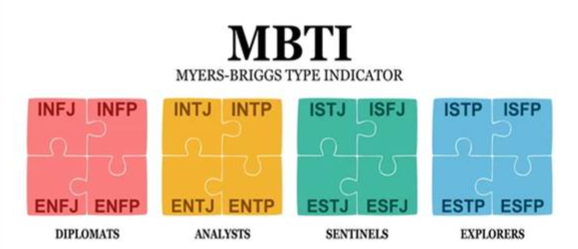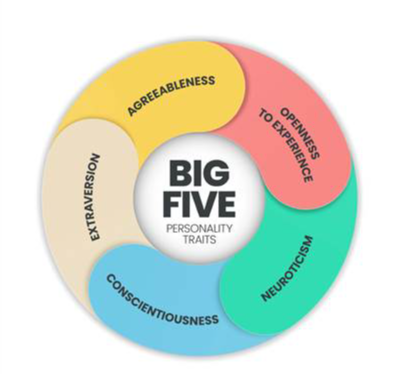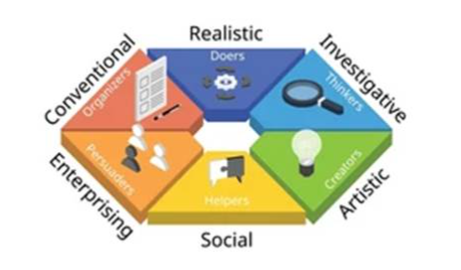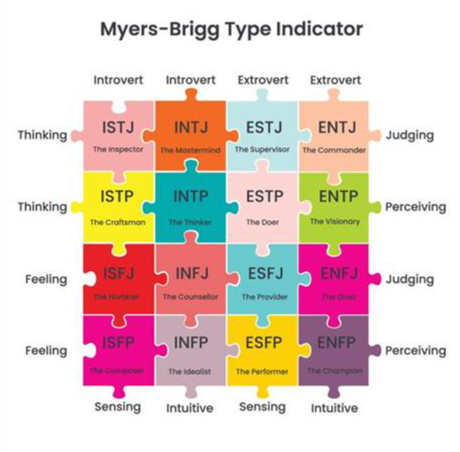
- Introduction
Personality is a characteristic way of an individual’s thinking, feeling and behaving. Personality involves mood, attitudes, interests and behaviours of the individual. It includes behavioral characteristics, both inherent and acquired, that distinguish one person from another and that can be observed in people’s relations to the environment and to the social group.
Personality tests are carefully designed tools to systematically elicit information about a person’s interests, motivations, preferences, emotional make-up, work style and style of interacting with people and situations. Personality can be described using a combination of traits and dimensions. For example, people high in integrity may follow the rules and be easy to supervise but they may not be good at providing customer service because they are not outgoing, patient, and friendly.
- Overview of the personality tests
Myers-Briggs Type Indicator (MBTI)
The Myers-Briggs Type Indicator is one of the most popular personality tests in the world. It was developed based on the Carl Jung’s work. The model uses a series of questions to categorise individuals into one of 16 types, these 16 personalities are developed based on 4 distinct dichotomies.

Holland RAISEC model
The Holland Occupational Themes is a vocational and career personality theory. It is a theory that classifies individuals into six occupational types based on fit. The six types make up the acronym RIASEC, which is commonly used as a label for the theory. John L. Holland initially developed the theory.
The typology has had profound impact on the career counseling profession and has been a component of most contemporary tests used in the profession. The RIASEC Markers from the Interest Item Pool were developed for research purposes in psychology and provide a publicly accessible alternative to the commercially implemented tests.

3. Understanding the differences between the personality tests
Feature / Model | MBTI | Big Five | RIASEC Model |
|---|---|---|---|
Basic Idea | Categories people into 16 personality types based on 4 dimensions | Measures personality across 5 broad traits (Openness, Conscientiousness, Extraversion, Agreeableness, Neuroticism) | Matches personality types with career environments using 6 categories |
Purpose | Helps people in understanding their interests, influences and work style and behaviours | Helps in describing the | Connects personality types with job environments for better career satisfaction |
Career Guidance Use | Suggests suitable career paths based on natural preferences (e.g., INTJ may enjoy strategic planning or research roles) | Helps identify work habits, team behaviour, and career traits like reliability, curiosity, or stress tolerance | Directly links personality type to job sectors (e.g., Artistic = design, Conventional = accounting) |
How It Affects Career Choice | People tend to pick roles that match their thinking, decision-making, and interaction style | Influences job performance and preference (e.g., high conscientiousness → good for structured jobs) | Encourages choosing careers that align with personal interests and values |
Common for Students? | Widely used in career counselling for students | Used in research and personality coaching, increasingly adopted in student career assessments | Often used in schools and career centres for easy career mapping |
Strength | Easy to understand, promotes self-awareness, widely available | More scientific and reliable, captures personality depth | Simple match between personality and job type, easy for students to visualise paths |
Weakness | Can oversimplify, lacks scientific support | May feel too abstract for direct career advice | Can limit exploration outside suggested types |
Example Use Case | A student who is ENFP might be guided toward marketing, counselling, or public relations | A young professional with high openness and low neuroticism may thrive in innovative, high-pressure roles | A student identified as “Investigative” may be advised toward careers in science or tech |
Best For | Understanding working styles and team fit | Understanding long-term behaviour and workplace potential | Choosing a career path based on interest areas |
- MBTI personality test and its impact on career choice prospects
The MBTI is based on the idea that our personality is made up of four dimensions, each has two opposites (dichotomies).
They are:
- extraverted (E) or introverted (I)
- sensitive (S) or intuitive (N)
- thinking (T) or feeling (F)
- judgmental (J) or perceptive (P)
The MBTI test requires the individual to answer the questionnaire of about 93 questions to determine which of the two sides of the personality spectrum they lean into.
The test outcome helps in understanding their preferences, strengths, weaknesses and compatibility with others and can influence the career path they can choose moving forward.
Let’s take a look at these aspects.
Extraversion (E) – Introversion (I)
Extraversion is often referred to as the tendency to be sociable and energised by action and interactions with people While Intraversion refers to as the tendency to focus on thought-provoking ideas, deep conversations and fewer people interactions.
Perceiving: Sensing (S) – Intuition (N)
This dichotomy is about how do we perceive and make sense of the world around us. Sensing people would likely prefer concrete facts, established precedents, and specific details. Intuitive people would prefer to explore patterns, relationships, and possibilities through imagination.
Judging: Thinking (T) – Feeling (F)
This part of personality dichotomy is about how people perceive decisions on a day to day basis. Thinking people are more likely to be able to stay consistent, logical and objective during decision-making while feeling people are more likely to consider the emotions and the needs of other people during decision making.
Judging (J) – Perceiving (P)
This dimension of the personality test involves the individual’s preference for judging or perceiving the world around us. A judging individual will likely want things to be settled quickly and will exhibit either thinking or feeling styles in their decision-making, whereas a perceptive individual would likely be more open and flexible to views and less interested in coming up with conclusions.
5. Personality types and their possible career fits
MBTI Type | Key Traits | Career Choices |
ISTJ | Organized and practical | Military, business administration, law enforcement |
ISFJ | Caring and loyal | Accounting, legal, engineering |
INFJ | Idealistic and insightful | Nursing, teaching, counseling |
INTJ | Analytical | Healthcare, administration, social work |
ISTP | Calm and logical | Sales, emergency services, entrepreneurship |
ISFP | Perceptive, artistic, sensitive | Technical fields, mechanics, law enforcement |
INFP | Imaginative | Performing arts, sales, hospitality |
INTP | Curious and deep thinker | Arts, healthcare, therapy |
ESTP | Energetic and bold | Teaching, counseling, leadership |
ESFP | Outgoing and expressive | Counseling, creative arts, healthcare |
ENFP | Enthusiastic | Creative fields, teaching, marketing |
ENTP | Persuasive | Writing, counseling, activism |
ESTJ | Structured, leadership-focused and organized | Executive roles, law, consulting |
ESFJ | Calm, sympathique and helpful | Sciences, technology, strategy |
ENFJ | Charismatic, and motivating | Entrepreneurship, law, media |
ENTJ | Visionary | Sciences, research, technology |

6. How to use your Myers-Briggs type to choose a career
When searching for a career, personality type is an important factor to consider. The personality test can help a choose a career path and job prospects that are better aligned with the nature and personality type of the individual. Therefore, here are the various ways to use the Myers-Briggs test results to choose your career:
1. Study your personality type
2. Research jobs that fit with your personality type
3. Find your career passion
4. Set SMART goals
1. Study your personality type
Once you receive the results of your personality test, take a look at the behaviours that align with your personality type. You may notice that it was either what you expected or contrary to your expectations. When you tie in the results of your personality type to you actions, you can get a feel for what career prospects may suit your nature well.
2. Research jobs that fit with your personality type
In finding out personality type, you may be able to determine the career you would like to work in. The other option is to use the jobs that align with your personality type as a roadmap to reaching your career goals
3. Find your career passion
It takes patience, time and awareness to understand what you’re passionate about. You will have to explore yourself on a day to day basis through many techniques that the researchers have suggested such as journaling, trying new things, exploring new ways of doing things or travelling.
4. Set SMART goals
Goal setting is an essential aspect reaching your desired career. Without a proper goal, it’ll be difficult to find a roadmap to advance your career. However, the SMART (Specific, Measurable, Actionable, Relevant and Time-based) framework will be helpful in clearly setting your objectives, and after that you can determine what line of work you would like to be in.
7. Conclusion
Knowledge of personality types is an important indicator of good career decisions. All personality models such as MBTI, the Big Five, and Holland’s RIASEC, each provide a different perspective to knowing one’s strengths, likes, and working styles. These can help guide students and novice professionals to choose a career consistent with their natural tendencies, emotional styles, and interaction styles.
The MBTI personality test generally provides job fit recommendations for each type, while the Big Five helps in quantifying long-term fit for the compatible job requirements, and the RIASEC model helps in determining individuals in their interests and career environments.
By exploring personality type, individuals can do the research into compatible career options available for them, helps them understand their nature and interests and work type, and also helps in setting SMART goals for the future. Rather than creating chaos and confusion, personality information offers more open, and more personalized career options and Job opportunities to find work that truly fits who they are.
FAQs
1. How does personality testing aid professional development for you?
Personality tests enables the users to understand their influences, strengths, weakness, work style and influential characteristics. With that knowledge, they will be able to find the career options that best fit their innate nature, interests and personality
2. How does the MBTI test impact career choices?
Myers Briggs Type Indicator (MBTI) sorts individuals into 16 types based on four basic dichotomies (e.g., Extraversion/Introversion). Each type implies personality style that lean towards decision making style, sociability, work ethics. This helps them choose the career that fits them best.
3.Big Five personality test and MBTI: how are they different?
In contrast to MBTI, where a person is typed, Big Five quantifies personality traits. It assesses Openness, Conscientiousness, Extraversion, Agreeableness, and Neuroticism—giving a better understanding of behavioral tendencies that contribute to long-term career success.
4.How does the Holland RIASEC model correlate with personality and career?
The RIASEC model classifies individual characteristics and interests and maps them into six different work settings: Realistic, Investigative, Artistic, Social, Enterprising, and Conventional.
5. What do I do after I’ve determined my personality type?
After you have identified your type:
1. Know your personality traits in depth
2. Identify job chances that best fit your special personality traits.
3. Determine your interests through participating in different activities.
4. Set SMART goals
5. Find your career passion
References
1. Myers–Briggs Type Indicator (MBTI): Is it a useful measure of personality? Psychology Research and Behavior Management, 12, 187–198.
[https://pmc.ncbi.nlm.nih.gov/articles/PMC6671867/]
2. Trait and factor theories: Parsons and Williamson [PowerPoint slides]. Scribed.
3. Holland’s theory. In Science Direct Topics.
4. Holland’s theory of career choice and you. Career Key.
5. Holland personality types. Career Key.
6. Intelligence, personality, and interests: Evidence for overlapping traits. Personality and Individual Differences, 23(1), 147–163.
[https://www.sciencedirect.com/science/article/abs/pii/S0191886997000044]
7. Autonomy as a moderator of the relationships between the Big Five personality dimensions and job performance. Personnel Psychology, 56(2), 365–393.
[https://onlinelibrary.wiley.com/doi/abs/10.1111/j.1744-6570.2003.tb00143.x]
8. MBTI vs Big Five personality traits.
9. Is Big Five better than MBTI? Research Gate.
The effects of trait-factor theory based career counselling sessions on the levels of career maturity and indecision of high school students. Research Gate.
Penned by Abhinav Asthana
Edited by Sneha Seth, Research Analyst
For any feedback mail us at [email protected]
Streamline Your Hiring with Eve Placement’s Custom Assessments
Eve Placement helps you engage, assess, and recruit top talent through tailored hiring challenges that go beyond resumes. From technical quizzes and real-world case studies to psychometric evaluations and audio/video submissions, our platform enables smarter, data-driven hiring decisions. Advanced security features ensure authenticity and eliminate fraud, giving you reliable results. Ready to hire better? Know More.
Mail us at [email protected]